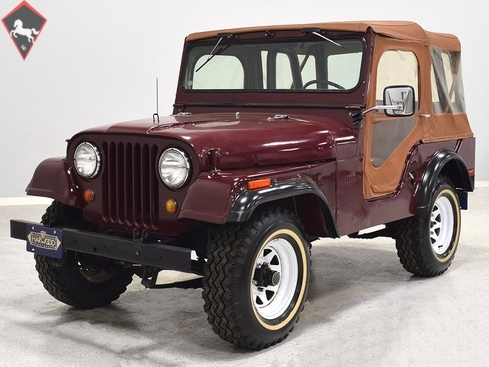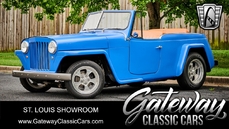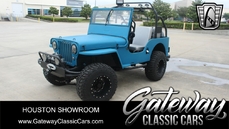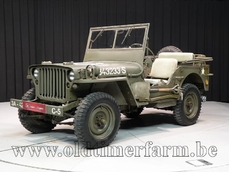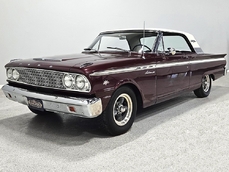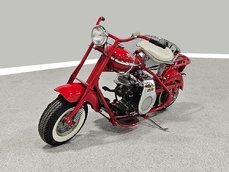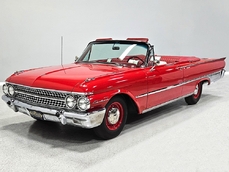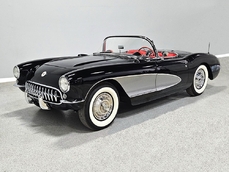Willys Jeep 134 cubic inch inline-4 1965
General description :
Older amateur restoration of a pre-AMC Jeep CJ5. Runs and drives great, recent top and doors, upgraded stereo. Nice color combination on a traditional Jeep. If you have somewhere remote to go and want to have fun doing it, this Jeep is the answer.
The restoration was finished in the ‘80s, so it’s not fresh, but you can tell this Jeep has been loved. It’s not perfect, of course, but it has clearly been used as intended: having adventures in remote places. We have a fairly large stack of receipts on the restoration, and they covered all the big stuff so it’s in good order. The paint has a decent shine and the bodywork is Jeep-appropriate—not perfect, but not at all rusted. Sure, there are a few signs of use, a few dings here and there, and plenty of off-road scars, but that’s how a Jeep should look, isn’t it? Perfection is over-rated and perfect Jeeps never get to have any fun in the mud. Instead, this one delivers fun all out of proportion to its price tag and the low-worries cosmetics mean that you can head out into the wilderness without guilt. The traditional Jeep styling cues are all there, from the seven-bar grille and round headlights to the folding windshield to the spare tire mounted out back. As I mentioned, there’s no critical rust or rot in the tub and it has that charming Jeep look that has been loved for decades. This is an affordable, easy way to get into the Jeep lifestyle.
The interior is bare-bones, make no mistake. If you want comfort and luxury, a Jeep isn’t a smart choice. But if you want the ability to go anywhere and just hose it out when you’re done, this is a great vehicle. The seat covers are in great shape and the tan upholstery is a nice contrast to the burgundy paint job. Rubber mats on the bare metal floors mean getting dirty shouldn’t be optional, and the three-spoke steering wheel probably dates to WWII. A full complement of gauges are arrayed ahead of the driver, along with a set of toggle switches for auxiliary functions like lights and wipers. There’s also a heater control unit under the dash and an ‘80s Alpine AM/FM/cassette head unit in the dash with speakers at either end. The shifter features a chrome knob, and controls a 3-speed manual transmission, with auxiliary levers for the transfer case and front axle. Seat belts were added during the restoration, which is probably not a bad idea, and the back seat looks almost completely unused. There’s also a recent tan top and doors which are easy to remove for the open-air Jeep experience.
Power comes from the familiar Kaiser/Willys 134 cubic inch “Hurricane” 4-cylinder engine. A powerhouse it isn’t, but it’s bulletproof reliable and it was built by guys who understood what a Jeep was designed to do. It starts easily with a gruff 4-cylinder bark from the tailpipe and there’s decent low-end torque to make it feel peppy around town. With plenty of gear in the transfer case, particularly low range, it’s still potent off road and will get you anywhere you need to go. There are lots of cool features, too, including the remote air filter that helps with deep water fording, a big heater unit on the driver’s side firewall, and a thick radiator designed for slow-speed work. The 3-speed transmission shifts nicely with light clutch action and in low range this thing has the moves of a mountain goat. The undercarriage is a bit grungy, but that only means it has been used for its intended purpose and again, there’s no serious structural rot that should cause any concern. Leaf springs ride reasonably well and offer surprising axle articulation, and the no-frills hardware means that low maintenance is the word of the day. 4-wheel drum brakes are plenty powerful for the Jeep’s modest performance and light curb weight, and it sits on familiar 15-inch steel wheels with ancient retro-cool L78-15 off-road whitewalls.
Extras include an Army service manual and a massive stack of receipts covering the last four decades.
Fun on a budget has always been Jeep’s strong suit, and this neat little CJ5 asks for very little in return for the smiles it delivers. Not perfect, but perfect for going on an adventure, it’s a great way to get into off-roading without a major investment. And no matter where you go, this little 4x4 generates smiles and good memories, so you’ll always be a celebrity when you drive it. Call today!
Harwood Motors always recommends and welcomes personal or professional inspections of any vehicle in our inventory prior to purchase.
1965 Willys Jeep 134 cubic inch inline-4 is listed for sale on ClassicDigest in Ohio by Harwood Motors for $11900.
Car Facts
Car type : Car Make : Willys Model : Jeep Model Version : 134 cubic inch inline-4 Engine size : 0.0 Model Year : 1965 Location : Ohio Vehicle Registration : Undefined
11900 $
People who viewed this Willys Jeep also viewed similar Willys listed at ClassicDigest
Other cars listed for sale by this dealer
About Willys
The Willys-Overland Company, later known simply as Willys, was an American automobile manufacturer that played a significant role in automotive history. Here's an overview of the story of Willys:Early Years:
Founding: The company was founded by John North Willys in 1908 in Toledo, Ohio, initially as the Willys-Overland Motor Company. John Willys acquired the Overland Automotive Division of Standard Wheel Company, which produced the Overland automobile.
Early Success: Willys-Overland experienced success in the early 1910s, producing vehicles like the Overland Model 79, which was a popular car due to its affordability and reliability.
World War I:
Military Contracts: During World War I, Willys-Overland secured significant contracts to supply vehicles for the war effort. The company's production capabilities were crucial for the military, producing trucks and automobiles for various purposes.
Introduction of the Jeep:
WWII Contribution: In the build-up to World War II, Willys-Overland, along with other automakers, responded to the U.S. Army's request for a lightweight, all-terrain reconnaissance vehicle. The company developed the Willys MB, which became the iconic Jeep.
Jeep Legacy: The Jeep, with its ruggedness, versatility, and reliability, played a crucial role in World War II. Its success led to the establishment of the Jeep brand, known for producing off-road vehicles that gained popularity in both military and civilian applications.
Post-War Period:
Civilian Jeep Models: After the war, Willys introduced civilian versions of the Jeep, like the CJ (Civilian Jeep) series, which were adapted from the wartime Willys MB. These vehicles became popular for off-road and recreational use.
Willys' Evolution and Later Years:
Ownership Changes: Willys-Overland faced financial difficulties and changed ownership several times in the post-war years, eventually becoming the Kaiser-Jeep Corporation after being acquired by Kaiser Motors in the 1950s.
End of Willys: In 1970, the American Motors Corporation (AMC) acquired Kaiser-Jeep. The Willys nameplate gradually faded away as AMC focused on the Jeep brand. Later, Chrysler acquired AMC in the 1980s and continued the production and development of Jeep vehicles.
Legacy:
Willys' legacy is primarily associated with its contribution to the automotive industry through the creation of the Jeep, a vehicle that transformed mobility during World War II and became an iconic brand in its own right. The Jeep's reputation for durability, versatility, and off-road capability originated from the innovations and success of Willys-Overland during wartime.
